Acer Predator Helios 300 Gaming Laptop PC
Acer Predator Helios 300 Gaming Laptop PC
Ignite Fusion
Ready for battle and eager for a fight, the Helios 300 drops you into the game with everything you need. Only now we’ve armed it with NVIDIA GeForce GTX 1660 Ti graphics, the latest 9th Gen Intel Core i7 Processor and our custom-engineered 4th Gen AeroBlade 3D Fan Technology. With the 144Hz IPS panel and 3ms Overdrive response time you can say farewell to blur and hello clear, crisp, high-octane gameplay.
9th Gen Intel Core i7-9750H 6-Core Processor
With a killer combination of smart features, the Intel Core i7 processor is devastatingly powerful.
NVIDIA GeForce GTX 1660 Ti Graphics
Powered by a GeForce GTX 1660 Ti GPU, this laptop delivers fast, smooth gaming experiences you want.
New 4th Gen Aeroblade 3D Fan
Keep the performance up and the heat down with the 4th Gen AeroBlade 3D Fan Technology.
The Ultimate Smooth Game Play
Enjoy an incredibly fast 144Hz refresh rate and 3ms Overdrive response time in Full HD for frames that are crisp and clear for high-octane gameplay. The ultimate gaming display for enthusiast gamers.
Take Control of the Game
PredatorSense is the ultimate tool to control and customize your gaming experience from one place.
Just tap the PredatorSense key and take
command over lighting, fan speed, overclocking,
game profiles and more.
What else could you ask for?
Killer DoubleShot ProWith Killer
DoubleShot Pro, choose which
applications take up precious bandwidth.
Bandwidth prioritization is user controlled in
the Control Center.
Acer Predator Helios 300 Gaming Laptop PC
Predator Gaming Accessories

Predator Galea Headset
Specification:True Harmony Technology
Feature:Adjustable Headband Design
Detail:Suspended Headband Design
Design:Retractable Microphone
Spec:Soft Cushioned Ear Pads

Predator Cestus RGB Mouse
Specification:Dual Omron Switch Design
Feature:Predator Quarter Master SW
Detail:On-Board Memory
Design:16.8 million RGB Colors
Spec:—

Predator Aethon Keyboard
Specification:Kailh Blue Switches
Feature:10 Lighting Effects
Detail:109 standard keys
Design:5 Macro Keys
Spec:Switch Life 70 million Strokes
Predator Aethon Keyboard

Predator Gaming Backpack
Specification:Soft Padded Shoulder Straps
Feature:Water-repellent
Detail:Padded Interior and Pockets
Design:Headset Strap (certain models)
Spec:—

Predator Gaming Backpack
Specification:Tightly Woven Textile
Feature:Reduced Friction Surface
Detail:Non-slip Rubber Base
Design:Heat-bound Edges
Spec:Oil, Water and Heat Resistant

Product description
Style:Notebook only
Acer Predator Helios 300 PH315 52 78VL Gaming Laptop comes with these high level specs: 9th Generation Intel Core i7 9750H 6 Core Processor 2.6GHz with Turbo Boost Technology up to 4.5GHz, 15.6" Full HD (1920 x 1080) widescreen LED backlit IPS display, 144Hz Refresh Rate, 16:9 aspect ratio, 3ms Overdrive Response Time, 300nit Brightness, 72 percent NTSC, NVIDIA GeForce GTX 1660 Ti with 6GB of dedicated GDDR6 VRAM, 16GB DDR4 2666MHz Memory, 256GB PCIe NVMe SSD (2 x PCIe M.2 Slots | 1 Slot Available), 1 Available Hard Drive Bay, Waves MaxxAudio sound technology, featuring MaxxBass, MaxxVolume, MaxxDialog and hyper realistic 3D Audio using Waves Nx, Acer True Harmony Technology, Two Built in Stereo Speakers, Acer Purified.Voice technology with two built in microphones, Killer Double Shot Pro Wireless AC 1550 802.11ac WiFi featuring 2x2 MU MIMO technology (Dual Band 2.4GHz and 5GHz), Killer Ethernet E2500 10/100/1000 Gigabit Ethernet LAN, Bluetooth 5.0, HD Webcam (1280 x 720) supporting Super High Dynamic Range (SHDR), 1 USB 3.1 Type C Gen 2 port (up to 10 Gbps), 3 USB 3.1 Gen 1 Ports (One with Power off Charging), 1 HDMI 2.0 Port with HDCP Support, 1 Mini Display Port 1.4, Backlit Keyboard, Lithium Ion Battery, Up to 6 hours Battery Life, 5.07 lbs. | 2.3 kg (system unit only) (NH.Q5MAA.001).Processor Speed : 2.60 GHz

Verdict
There’s plenty to like about the Acer Predator Helios 300: the GTX 1660 Ti is a great gaming chip, it’s paired with a solid specification elsewhere, and the screen is excellent. The exterior looks good, and it isn't bad ergonomically. Other machines are slimmer, lighter and cheaper, but the Acer delivers an effective and well-balanced gaming experience at a decent price.
Pros
Solid 1080p gaming ability
Versatile Core i5 CPU
Excellent screen quality
Consistent quality for the price
Cons
Keyboard could be a little better
Exterior is too weak, thick and heavy
RTX 2060 is a better GPU
Key Specifications
Nvidia GTX 1660 Ti 6GB
15.6in 1920 x 1080 144Hz
Intel Core i5-9300H CPU
8GB 2666MHz DDR4 memory
256GB SSD, 1TB hard disk
Windows 10 Home 64-bit
1yr RTB warranty
What is the Acer Predator Helios 300?
The Acer Predator Helios 300 (PH315-52-52ZM) is a mid-range gaming laptop that promises a smooth 1080p gaming experience inside an eye-catching exterior.
That’s all well and good, but this machine isn’t the only affordable gaming device I’ve seen recently. The Asus ROG Zephyrus G made many of the same claims as the Acer, and it was cheaper.
Acer Predator Helios 300 design – Unmistakably a gaming laptop, but is lacking on the port front
The Predator Helios 300 looks good, with a body coated with dark, matte metal. Blue accents surround the touchpad, highlight important buttons and light up the lid.
Elsewhere, the Acer has subtle angles and smart edges, with the only extravagant design to be found in the small air vents, where the metal is painted blue. The Helios is unmistakably a gaming laptop, but it’s not the most out-there design.
Skip in 5

In other areas, the design is middling. Build quality is only average: the metal of the wrist-rest moves too much, and the screen can easily be flexed back and forward. The Acer isn’t weak, but investing in a protective sleeve would be wise.
The port selection is nothing to shout about. You get three USB 3 ports, a single Type-C connection and a sole audio jack. There are HDMI and mini-DisplayPort outputs. However, the Acer is missing faster, full-size USB 3.1 ports, and there’s no card reader or Thunderbolt either.

Finally, we come to the Helios 300’s dimensions. The Acer is 23mm thick and weighs 2.4kg, making it chunkier next to rival machines.
Related: The Best FPS games
Acer Predator Helios 300 keyboard and trackpad – Despite a firm base and reasonable travel, keys feel spongey
The Acer’s keyboard has a good layout: there’s a number pad, the cursor and Return keys are full-size, and many of the key buttons have blue highlights. The font is easily legible, and there’s a dedicated button to launch Acer’s PredatorSense app.
The typing action isn’t bad, either. The metal beneath the keyboard is stronger than that used on the wrist-rest, which means the base is firm. As such, hammering the buttons down feels more satisfying and consistent. The buttons also have a reasonable amount of travel, which helps it to feel more robust while typing.

It’s not all good news, however. The buttons are still a little soft, despite the firm base and reasonable travel. That means they’re a tad spongey when compared to the keyboards of the best gaming notebooks.
For mainstream gaming, eSports and typing, the slightly soft buttons won’t prove so much of an issue. If you’re a keen gamer who prefers a crisper, firmer feel, however, you’ll want to look elsewhere.
The Acer’s trackpad is okay, with a smooth surface that supports gestures. Its two built-in buttons are reasonable, with a snappy action. However, for those who really want to enjoy their gaming experience, a USB mouse will be better – as is the case with any gaming laptop.
Related: Best Gaming Laptops
Acer Predator Helios 300 screen and sound – Decent set of speakers accompany a great quality screen
The Acer has a 15.6in screen with a 1080p resolution, which is fine for gaming. It’s high enough to provide crisp imagery, but without putting too much strain on the graphics core.
It’s an IPS panel with a 144Hz refresh rate and a rapid 3ms response time. There’s no Nvidia G-Sync, so gaming isn’t as smooth as it could be, but it’s still be very good indeed. The Acer’s panel also has a better specification than the Asus ROG Zephyrus G, which topped out at 120Hz with a worse response time.
The Acer offers great quality too. Its brightness of 343 nits is high, and means the Helios can cope under bright artificial lights and outdoors. It’s joined by a black level of 0.28 nits, which helps bring suitable depth to dark areas. Those figures create a contrast ratio of 1225:1, which is high enough to provide good vibrancy and punch in every situation.

The average Delta E of 3.03 is accurate enough to ensure there are no noticeable colour discrepancies in games, and the colour temperature of 6758K is great – close to the 6500K ideal.
The Acer’s weakest result was an sRGB coverage level of 84.9%. That’s still fine for games, though – the vast majority of the shades required will be rendered by this screen.
The Asus was much worse. Its contrast of 1074:1 was lower, its Delta E sat at 4.65 and it only rendered 57.5% of the sRGB gamut. For gaming, it’s no contest.
The Acer has reasonable speakers, with decent volume and enough clarity to get away with gaming. However, a headset is always advisable for better audio.
Related: Best Gaming Mouse
Acer Predator Helios 300 performance – The laptop shows good pace, but there’s no support for ray-tracing
The Acer’s key component is the GeForce GTX 1660 Ti. It’s one of Nvidia’s newer and more affordable chips, and it represents the stepping stone between last year’s 10-series GPUs and the newer RTX 20-branded cards.
The halfway house positioning means the GTX 1660 Ti has a curious specification. It uses the same Turing architecture as Nvidia’s latest GPUs, but the RT and Tensor cores have been omitted. That means the mid-range GTX 1660 Ti can’t handle ray-tracing or DLSS – Nvidia’s two new flagship technologies.
Still, those technologies aren’t available on many games right now, so it isn’t a huge loss – especially at this price.

Elsewhere, the GTX 1660 Ti has 1536 stream processors and 6GB of memory, and it rattles along at 1770MHz. It’s a step ahead of the cheaper Asus, which included the GTX 1660 Ti Max-Q: the same core running at a reduced clock speed of 1,335MHz.
The extra graphical power makes its presence known in benchmarks. In 3DMark: Fire Strike, the full-power GTX 1660 Ti scored 11,647 points; the Max-Q version only scored 10,850.
That advantage translated to real-world tests. The Acer’s Shadow of the Tomb Raider average of 74fps is six frames better than the Asus, and it scored 109fps in Shadow of Mordor – nine frames quicker. It’s seven frames faster in Battlefield V.
The Helios 300 shows good pace. The GTX 1660 Ti will play any of today’s top single-player games at 1080p – and it will do it with more speed and for longer into the future than the Asus, thanks to that slight performance improvement. Esports games and less-demanding titles will run at beyond 100fps, which means they can be butter-smooth on the 144Hz screen.
However, the toughest single-player titles won’t run at beyond 100fps unless you dial back the graphics settings. You don’t get ray-tracing, and there still isn’t enough power here to handle outputting to VR headsets or to higher resolutions.
If you do want more power, a RTX 2060 laptop is better. Machines with that GPU typically score around 14,500 in 3DMark: Fire Strike, but prices start at £1299 and quickly increase.
The full-power GTX 1660 Ti is paired with a Core i5-9300H. It’s one of Intel’s latest mid-range chips, and it has four Hyper-Threaded cores with base and boost speeds of 2.4GHz and 4.1GHz. It’s joined by 8GB of memory, a 256GB SSD and a 1TB hard disk.

This is another area where the Acer outpaces its more affordable Asus rival. The Asus included a quad-core Ryzen 7 3750H that couldn’t keep up in benchmarks.
In Geekbench, the Acer’s Core i5 returned single- and multi-core scores of 4590 and 13,211. Both results are a little better than the Asus. The Acer then scored 800cb in Cinebench – which is again marginally quicker than its cheaper rival.
The difference in CPU performance isn’t huge. In games and in day-to-day tasks, such as web browsing and Office tools, both machines will be just as quick. However, if you want to run tougher applications, such as photo-editing software, the Acer’s Intel CPU will be better.
The Acer is better when booting and loading games too, thanks to its SSD. Its read and write speeds of 2863MB/s and 1600MB/s easily beat the 1415MB/s and 988MB/s of the Asus.
The Acer has no thermal problems. Its peak CPU and GPU temperatures of 80ºC and 70ºC are fine, and around 10ºC better than the Asus. None of the heat makes its way to the exterior panels, and the noise levels are fine too – there is inevitable fan noise, of course, but it’s no worse than rivals and can be easily drowned out by a headset.
In a low-end application test, the Acer’s battery lasted for 4hrs 30mins. That’s actually a couple of hours behind the Asus – so if you want a machine to handle some work away from the mains, the cheaper Asus is a better bet.

In a gaming test the Acer lasted for just over an hour, which is also a little behind the Asus. However, it’s somewhat moot – both machines need plugging in for a proper gaming session.
There’s one other attractive thing about the Acer: the number of alternative specifications available. This machine can be upgraded with a Core i7-9750H processor , and a 17.3in variant . Larger 17.3in models with the Core i5 and Core i7 CPUs and the RTX 2060 .
The Asus, on the other hand, is only available in its sole AMD and GTX 1660 Ti configuration.
Related: Best Streaming Sites
Should I buy the Acer Predator Helios 300?
The Acer Predator Helios 300 is an affordable laptop, which does mean a compromised design. For the most part, however, this system excels in the most important areas.
The full-power GTX 1660 Ti is quicker than the Max-Q version and fast enough for 1080p and eSports gaming. It can’t handle ray-tracing or anything beyond 1080p, but that’s expected at this price. Similarly, the CPU is rapid enough for gaming and for day-to-day computing, and the storage and thermal performance are good.
Elsewhere, the screen is excellent and the keyboard and exterior design are all fine, if not brilliant. Battery life is middling, but that’s no surprise with a gaming laptop.
The cheaper Asus also offers reasonable 1080p gaming power, and it’s a little slimmer and lighter than the Acer. However, its GPU and CPU both fall behind the Acer and it has a far poorer screen.
The Acer may cost a little more, but it doesn’t break the bank – and the extra money allows it to offer more computing power and a better-balanced experience. It’s a great option for affordable gaming.
Acer Predator Helios 300 Laptop Review: A modern gaming laptop with a Turing GPU
A useful gaming device! The Predator series is well known for its gaming devices, with Acer selling more than just laptops under its gaming sub-brand. While the company continues to sell Predator-branded accessories, it has overhauled the design and internals of its latest Predator Helios laptop. The Helios 300 should make for a compelling midrange gaming laptop, but our tests will reveal whether that is the case or not.

The Predator Helios 300 is well known around here, with two models in the last two years having graced our offices. Now, the company has released a new device that includes not only improved hardware but also an overhauled design. Our review unit is called the Helios 300 PH315-52-79TY and features an Intel Core i7-9750H processor along with an NVIDIA GeForce GTX 1660 Ti GPU. The device also has 8 GB of RAM and a 512 GB SSD. The latter two are the smallest that Acer offers, for reference. The Helios 300 has a 15.6-inch 144 Hz display too, as do many other gaming laptops.
All SKUs come with hexa-core Coffee Lake processors, but there are NVIDIA GeForce RTX 20 series variants too, should you need something more powerful. The GeForce RTX 2070 is currently the strongest GPU on offer, while the Helios 300 can be configured with up to 32 GB of RAM. You can add up to two additional SSDs too if you need more storage than Acer offers.
We shall compare the new Helios 300 against comparable 15.6-inch gaming laptops. We have also chosen more expensive devices, like the Lenovo Legion Y740, but you can add others to our comparison tables too. We have included an overview of our comparison
Processor
Intel Core i7-9750H (Intel Core i7)
Graphics adapter
NVIDIA GeForce GTX 1660 Ti (Laptop) - 6144 MB, Core: 1455 - 1590 MHz, Memory: 6000 MHz, GDDR6 (Micron), Nvidia 417.88, Nvidia Optimus
Memory
8192 MB
, DDR4-2666, dual-channel, both SODIMM banks occupied
Display
15.6 inch 16:9, 1920 x 1080 pixel 141 PPI, AUO, B156HAN08.2, IPS, glossy: no
Mainboard
Intel HM370
Storage
WDC PC SN720 SDAPNTW-512G, 512 GB
, 512 GB M.2 PCIe, 420 GB free
Weight
2.311 kg ( = 81.52 oz / 5.09 pounds), Power Supply: 575 g ( = 20.28 oz / 1.27 pounds)
Price
1429 EUR
Links
Acer homepage
Acer notebook section
Note: The manufacturer may use components from different suppliers including display panels, drives or memory sticks with similar specifications.
Rating
|
Date
|
Model
|
83%
|
11/2019
|
Acer Predator Helios 300 PH315-52-79TY
9750H, GeForce GTX 1660 Ti (Laptop) |
84%
|
08/2019
|
HP Gaming Pavilion 15-dk0009ng
9750H, GeForce GTX 1660 Ti Max-Q |
83%
|
08/2019
|
Lenovo Legion Y540-15IRH-81SX00B2GE
9750H, GeForce GTX 1660 Ti (Laptop) |
83%
|
05/2019
|
Dell G5 15 5590
8750H, GeForce RTX 2060 (Laptop) |
85%
|
10/2019
|
Lenovo Legion Y740-15ICHg
9750H, GeForce RTX 2070 Max-Q |
82%
|
06/2018
|
Acer Predator Helios 300 PH317-52-51M6
8300H, GeForce GTX 1050 Ti (Laptop) |
Weight
|
Height
|
Size
|
Resolution
|
Best
Price
|
2.3 kg
|
23.2 mm
|
15.6"
|
1920x1080
|
from EUR 1429
|
2.4 kg
|
23.4 mm
|
15.6"
|
1920x1080
|
from EUR 1399
|
2.2 kg
|
26 mm
|
15.6"
|
1920x1080
|
from EUR 929
|
2.7 kg
|
23.7 mm
|
15.6"
|
1920x1080
|
from EUR 1399
|
2.3 kg
|
25 mm
|
15.6"
|
1920x1080
|
from EUR
|
2.9 kg
|
29 mm
|
17.3"
|
1920x1080
|
from EUR 1100
|
Case - A stable chassis with some flourishes
Acer Predator Helios 300 PH315
Acer no longer relies on a black and red design as it did with the last Helios 300. Instead, the company has switched to black and blue, although it has stuck with an aluminium and plastic chassis. While the aluminium keyboard deck and display lid help make the Helios 300 look premium, their matte finishes pick up fingerprints easily. Acer has adorned the device with some light blue accents too, which contrast nicely against the black aluminium. The Predator logo also has a blue backlight.
Our review unit is well made and sturdy. While our attempts to twist or dent the base unit were made in vain, we could twist the display lid slightly. The display resisted our efforts to temporarily deform it, though.
The Helios 300 has stable display hinges too. The two hinges not only hold the display tightly and keep teetering to a minimum, but they also allow for the device to be opened with one hand.
Advertisement






Size Comparison
The Helios 300 is comparatively compact for a 15.6-inch gaming laptop. While it has roughly the same dimensions as our comparison device, it only weighs 2.3 kg. The 180 W power supply weighs 575 g though, which you will probably also need to carry with you; more on that in the Power Management section of this review.
Acer no longer relies on a black and red design as it did with the last Helios 300. Instead, the company has switched to black and blue, although it has stuck with an aluminium and plastic chassis. While the aluminium keyboard deck and display lid help make the Helios 300 look premium, their matte finishes pick up fingerprints easily. Acer has adorned the device with some light blue accents too, which contrast nicely against the black aluminium. The Predator logo also has a blue backlight.
Our review unit is well made and sturdy. While our attempts to twist or dent the base unit were made in vain, we could twist the display lid slightly. The display resisted our efforts to temporarily deform it, though.
The Helios 300 has stable display hinges too. The two hinges not only hold the display tightly and keep teetering to a minimum, but they also allow for the device to be opened with one hand.
Advertisement






Size Comparison
The Helios 300 is comparatively compact for a 15.6-inch gaming laptop. While it has roughly the same dimensions as our comparison device, it only weighs 2.3 kg. The 180 W power supply weighs 575 g though, which you will probably also need to carry with you; more on that in the Power Management section of this review.
Connectivity - Plenty of ports, but no card reader
Acer has equipped the Helios 300 with all the ports that most gamers should need. The device has four USB 3.2 ports, of which one is Type-C. While you could connect the Helios 300 to an external display via its Type-C port, you could also use the dedicated HDMI and mini DisplayPort ports instead. Acer has included an Ethernet port too, but no card reader. Hence, you must have an adapter to hand if you want to transfer files from a memory card.
Acer has distributed the ports across the left and right sides of the device, as most OEMs do. However, these are flanked by large ventilation grilles that may exhaust warm air over your hands, regardless of with which hand you hold an external mouse. Cables may also get in your way, but both are minor gripes. There are two other ventilation grilles at the back of the device too.

Left-hand side: Kensington lock, fan vents, power connector, Ethernet, 2x USB 3.2 Type-A, 3.5 mm jack
Killer Wireless-AC 1550i
Acer has equipped our review unit with a Killer Wireless-AC 1550i chip, a picture of which we have included to the right of this section. The 1550i provided stable and fast transfer speeds during our tests, which allowed the Helios 300 to finish top of our iperf3 Client comparison tables overall. Last year's Helios 300 narrowly beat its successor in one test with its Intel Wireless-AC 9560, though.
The new Helios 300 has a Killer E2500 Ethernet controller on board too, which offers a Gigabit LAN connection. Ethernet worked just as well as Wi-Fi did during our tests.
Networking
Security
The Helios 300 does not offer many security features. There is a Kensington lock slot and a Trusted Platform Module 2.0 (TPM 2.0) on board, but Microsoft requires all OEMs include the latter in their devices if they sell them pre-loaded with Windows 10. Unfortunately, Acer does not offer a fingerprint scanner even as a configurable option.
Software
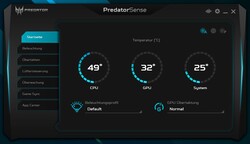
Acer has equipped our review unit with a Killer Wireless-AC 1550i chip, a picture of which we have included to the right of this section. The 1550i provided stable and fast transfer speeds during our tests, which allowed the Helios 300 to finish top of our iperf3 Client comparison tables overall. Last year's Helios 300 narrowly beat its successor in one test with its Intel Wireless-AC 9560, though.
The new Helios 300 has a Killer E2500 Ethernet controller on board too, which offers a Gigabit LAN connection. Ethernet worked just as well as Wi-Fi did during our tests.
Networking
iperf3 Client (receive) TCP 1 m 4M x10
|
|
Acer Predator Helios 300 PH317-52-51M6
Intel Wireless-AC 9560 |
692 MBit/s ∼100%0%
|
Acer Predator Helios 300 PH315-52-79TY
Killer Wireless-AC 1550i Wireless Network Adapter (9560NGW) |
672 (min: 658, max: 682) MBit/s ∼97%-3%
|
Dell G5 15 5590
Intel Wireless-AC 9560 |
657 (min: 556, max: 690) MBit/s ∼95%-5%
|
Average of class Gaming
(141 - 1490, n=286) |
620 MBit/s ∼90%-10%
|
Lenovo Legion Y540-15IRH-81SX00B2GE
Intel Wireless-AC 9560 |
619 MBit/s ∼89%-11%
|
Lenovo Legion Y740-15ICHg
Killer Wireless-AC 1550i Wireless Network Adapter (9560NGW) |
615 (min: 508, max: 642) MBit/s ∼89%-11%
|
HP Gaming Pavilion 15-dk0009ng
Realtek RTL8822BE Wireless LAN 802.11ac PCIe Adapter |
614 MBit/s ∼89%-11%
|
iperf3 Client (transmit) TCP 1 m 4M x10
|
|
Acer Predator Helios 300 PH315-52-79TY
Killer Wireless-AC 1550i Wireless Network Adapter (9560NGW) |
653 (min: 615, max: 670) MBit/s ∼100%+4%
|
Dell G5 15 5590
Intel Wireless-AC 9560 |
642 (min: 581, max: 693) MBit/s ∼98%+2%
|
Acer Predator Helios 300 PH317-52-51M6
Intel Wireless-AC 9560 |
640 MBit/s ∼98%+2%
|
HP Gaming Pavilion 15-dk0009ng
Realtek RTL8822BE Wireless LAN 802.11ac PCIe Adapter |
638 MBit/s ∼98%+1%
|
Lenovo Legion Y540-15IRH-81SX00B2GE
Intel Wireless-AC 9560 |
630 MBit/s ∼96%0%
|
Lenovo Legion Y740-15ICHg
Killer Wireless-AC 1550i Wireless Network Adapter (9560NGW) |
629 (min: 602, max: 651) MBit/s ∼96%0%
|
Average of class Gaming
(144 - 1420, n=286) |
|
Security
The Helios 300 does not offer many security features. There is a Kensington lock slot and a Trusted Platform Module 2.0 (TPM 2.0) on board, but Microsoft requires all OEMs include the latter in their devices if they sell them pre-loaded with Windows 10. Unfortunately, Acer does not offer a fingerprint scanner even as a configurable option.
Software

Predator Sense
Acer preinstalls its Predator Sense software on the Helios 300, just as it has with every gaming laptop that it has sold in the last few years. The company has given the software a blue and black skin to match the colour scheme of this year's Helios 300, which is a nice touch. Predator Sense now not only allows you to monitor the CPU and GPU but also overclock them slightly. You can change the keyboard's RGB backlighting in Predator Sense too.
Accessories
Acer only includes a 180 W power supply in the box, along with various pieces of documentation. The Helios 300 comes with Windows 10 Home 64-bit too, in case you were wondering.
Maintenance
The Helios 300 does not have a maintenance cover, but that is no bad thing as removing the bottom plate is a simple process. Doing so reveals the three drive bays, battery, Wi-Fi card and socketed RAM, among other components. Acer also includes the cable needed to add a 2.5-inch drive, which is handy.

Acer preinstalls its Predator Sense software on the Helios 300, just as it has with every gaming laptop that it has sold in the last few years. The company has given the software a blue and black skin to match the colour scheme of this year's Helios 300, which is a nice touch. Predator Sense now not only allows you to monitor the CPU and GPU but also overclock them slightly. You can change the keyboard's RGB backlighting in Predator Sense too.
Accessories
Acer only includes a 180 W power supply in the box, along with various pieces of documentation. The Helios 300 comes with Windows 10 Home 64-bit too, in case you were wondering.
Maintenance
The Helios 300 does not have a maintenance cover, but that is no bad thing as removing the bottom plate is a simple process. Doing so reveals the three drive bays, battery, Wi-Fi card and socketed RAM, among other components. Acer also includes the cable needed to add a 2.5-inch drive, which is handy.

A look at the Acer Predator Helios 300 PH315 with its bottom plate removed.
Warranty
The Helios 300 comes with 24 months' warranty. The coverage extends to a pick-up and returns service. Please see our Guarantees, Return Policies & Warranties FAQ for country-specific information.
Input Devices - RGB galore
Keyboard

Warranty
The Helios 300 comes with 24 months' warranty. The coverage extends to a pick-up and returns service. Please see our Guarantees, Return Policies & Warranties FAQ for country-specific information.
Input Devices - RGB galore
Keyboard

and with its backlighting enabled
Acer equips the Helios 300 with a 6-row chiclet keyboard that is slightly recessed into the chassis. All the keys sit firmly in their housings, and nothing rattles. The main keys measure 15 mm², which should be large enough for most hands, while all have a pleasantly short travel and noticeable pressure points. They also all have a dampened stop, which ensures that the keyboard remains quiet even when typing quickly. As the photo to the right reveals, Acer accents a few keys with a blue trim, but all keys support RGB backlighting. There is a Predator button too that opens the Predator Sense tool.
Trackpad

Acer equips the Helios 300 with a 6-row chiclet keyboard that is slightly recessed into the chassis. All the keys sit firmly in their housings, and nothing rattles. The main keys measure 15 mm², which should be large enough for most hands, while all have a pleasantly short travel and noticeable pressure points. They also all have a dampened stop, which ensures that the keyboard remains quiet even when typing quickly. As the photo to the right reveals, Acer accents a few keys with a blue trim, but all keys support RGB backlighting. There is a Predator button too that opens the Predator Sense tool.
Trackpad

A look at the trackpad on the Acer Predator Helios 300 PH315
Below the keyboard sits the trackpad, which measures 10.7 x 7.8 cm. The trackpad is large enough to perform multi-finger gestures and fits the overall look of the device. The one in our review unit remains responsive and accurate even into its corners, which is not always the case with modern laptops. Acer has integrated two mouse buttons too, which deliver a soft clicking sound when pressed. In short, the Helios 300 has a decent trackpad.
Display - A colour-accurate 144 Hz panel with no PWM

Below the keyboard sits the trackpad, which measures 10.7 x 7.8 cm. The trackpad is large enough to perform multi-finger gestures and fits the overall look of the device. The one in our review unit remains responsive and accurate even into its corners, which is not always the case with modern laptops. Acer has integrated two mouse buttons too, which deliver a soft clicking sound when pressed. In short, the Helios 300 has a decent trackpad.
Display - A colour-accurate 144 Hz panel with no PWM

Our review unit suffers from noticeable backlight bleeding
The Helios 300 has a 15.6-inch IPS display that resolves at 1920x1080. The 144 Hz panel is the only one that Acer offers with the device, but 1080p is roughly the limits of what its hardware offers.
Our review unit has an AU Optronics display, which achieved an average maximum brightness of 310 cd/m² according to X-Rite i1Pro 2. While not the darkest display in our comparison table, it is much dimmer than the one in the Lenovo Legion Y740. The display in the Helios 300 is not that evenly lit either, but its 0.255 cd/m² is relatively low. It also has a respectable 1,275:1 contrast ratio.
The panel does not use pulse-width modulation (PWM) to control brightness levels, which is a positive for those who are PWM sensitive. However, the one in our review unit suffers from significant backlight bleeding, as the photo to the right demonstrates.

The Helios 300 has a 15.6-inch IPS display that resolves at 1920x1080. The 144 Hz panel is the only one that Acer offers with the device, but 1080p is roughly the limits of what its hardware offers.
Our review unit has an AU Optronics display, which achieved an average maximum brightness of 310 cd/m² according to X-Rite i1Pro 2. While not the darkest display in our comparison table, it is much dimmer than the one in the Lenovo Legion Y740. The display in the Helios 300 is not that evenly lit either, but its 0.255 cd/m² is relatively low. It also has a respectable 1,275:1 contrast ratio.
The panel does not use pulse-width modulation (PWM) to control brightness levels, which is a positive for those who are PWM sensitive. However, the one in our review unit suffers from significant backlight bleeding, as the photo to the right demonstrates.
284
cd/m² 304
cd/m² 287
cd/m² 314
cd/m² 325
cd/m² 311
cd/m² 309
cd/m² 345
cd/m² 313
cd/m²
Distribution of brightness
AUO, B156HAN08.2
X-Rite i1Pro 2
Maximum: 345 cd/m² Average: 310.2 cd/m² Minimum: 18.4 cd/m²
Brightness Distribution: 82 %
Center on Battery: 326 cd/m²
Contrast: 1275:1 (Black: 0.255 cd/m²)
ΔE Color 4.28 | 0.6-29.43 Ø6, calibrated: 1.45
ΔE Greyscale 5.01 | 0.64-98 Ø6.2
93% sRGB (Argyll 3D) 60% AdobeRGB 1998 (Argyll 3D)
Gamma: 2.6
ICC File (X-Rite i1Pro 2)
| |||||||||||||||||||||||||
Distribution of brightness
AUO, B156HAN08.2
X-Rite i1Pro 2
Maximum: 345 cd/m² Average: 310.2 cd/m² Minimum: 18.4 cd/m²
Brightness Distribution: 82 %
Center on Battery: 326 cd/m²
Contrast: 1275:1 (Black: 0.255 cd/m²)
ΔE Color 4.28 | 0.6-29.43 Ø6, calibrated: 1.45
ΔE Greyscale 5.01 | 0.64-98 Ø6.2
93% sRGB (Argyll 3D) 60% AdobeRGB 1998 (Argyll 3D)
Gamma: 2.6
ICC File (X-Rite i1Pro 2)
Acer Predator Helios 300 PH315-52-79TY AUO, B156HAN08.2, IPS, 1920x1080, 15.6 |
Acer Predator Helios 300 PH317-52-51M6
LG Philips LP173WF4-SPF5 (LGD056D), IPS, 1920x1080, 17.3 |
Response Times
|
|||
Response Time Grey 50% / Grey 80% *
|
15 (8, 7)
|
-142%
|
|
Response Time Black / White *
|
9 (5, 4)
|
36 (18.8, 17.2)
-140%
|
|
PWM Frequency
|
22 (10.4, 11.6)
-144%
|
||
Screen
|
122000 (95)
|
||
Brightness middle
|
325
|
-25%
|
|
Brightness
|
310
|
365
12%
|
|
Brightness Distribution
|
82
|
341
10%
|
|
Black Level *
|
0.255
|
89
9%
|
|
Contrast
|
1275
|
0.32
-25%
|
|
Colorchecker DeltaE2000 *
|
4.28
|
1141
-11%
|
|
Colorchecker DeltaE2000 max. *
|
8.42
|
6.51
-52%
|
|
Colorchecker DeltaE2000 calibrated *
|
1.45
|
12.32
-46%
|
|
Greyscale DeltaE2000 *
|
5.01
|
2.9
-100%
|
|
Gamma
|
2.6 85%
|
7.65
-53%
|
|
CCT
|
7678 85%
|
2.64 83%
|
|
Color Space (Percent of AdobeRGB 1998)
|
60
|
8066 81%
|
|
Color Space (Percent of sRGB)
|
93
|
56
-7%
|
|
Total Average (Program / Settings)
|
86
-8%
|
||
-84% / -43%
|

60% AdobeRGB colour-space coverage
The Helios 300 is reasonably colour accurate despite this flaw, though. Acer did not factory calibrate the display in our review unit according to our tests, but its DeltaE deviations are still close to ideal values out of the box. Calibrating the display significantly improves colour accuracy and minimised the blue tint that affected our review unit, the ICC profile for which you can find in the box above our comparison table.
The display also covers 93% of the sRGB colour space and 60% of AdobeRGB. While neither is high enough for professional image and video-editing, they are both respectable coverages.

The Helios 300 is reasonably colour accurate despite this flaw, though. Acer did not factory calibrate the display in our review unit according to our tests, but its DeltaE deviations are still close to ideal values out of the box. Calibrating the display significantly improves colour accuracy and minimised the blue tint that affected our review unit, the ICC profile for which you can find in the box above our comparison table.
The display also covers 93% of the sRGB colour space and 60% of AdobeRGB. While neither is high enough for professional image and video-editing, they are both respectable coverages.

CalMAN: Colour saturation - calibrated
The matte display also gets bright enough to use the Helios 300 outdoors. We would still recommend using a shady spot where possible though as bright sunlight will make the display look washed-out.

The matte display also gets bright enough to use the Helios 300 outdoors. We would still recommend using a shady spot where possible though as bright sunlight will make the display look washed-out.

Using the Acer Predator Helios 300 PH315 outdoors in the shade
Display Response Times
ℹDisplay response times show how fast the screen is able to change from one color to the next. Slow response times can lead to afterimages and can cause moving objects to appear blurry (ghosting). Gamers of fast-paced 3D titles should pay special attention to fast response times.
Screen Flickering / PWM (Pulse-Width Modulation)
ℹTo dim the screen, some notebooks will simply cycle the backlight on and off in rapid succession - a method called Pulse Width Modulation (PWM) . This cycling frequency should ideally be undetectable to the human eye. If said frequency is too low, users with sensitive eyes may experience strain or headaches or even notice the flickering altogether.
Display Response Times
ℹDisplay response times show how fast the screen is able to change from one color to the next. Slow response times can lead to afterimages and can cause moving objects to appear blurry (ghosting). Gamers of fast-paced 3D titles should pay special attention to fast response times.
↔ Response Time
Black to White
|
|||
9 ms ... rise ↗ and fall ↘ combined
|
↗ 5 ms rise
|
||
↘ 4 ms fall
|
|||
The screen shows fast response rates in our
tests and should be suited for gaming.
In comparison, all tested devices range from 0.8 (minimum) to 240 (maximum) ms. » 8 % of all devices are better. This means that the measured response time is better than the average of all tested devices (24.9 ms). |
|||
↔ Response
Time 50% Grey to 80% Grey
|
|||
15 ms ... rise ↗ and fall ↘ combined
|
↗ 8 ms rise
|
||
↘ 7 ms fall
|
|||
The screen shows good response rates in our
tests, but may be too slow for competitive gamers.
In comparison, all tested devices range from 0.9 (minimum) to 636 (maximum) ms. » 10 % of all devices are better. This means that the measured response time is better than the average of all tested devices (39.5 ms). |
|||
Screen Flickering / PWM (Pulse-Width Modulation)
ℹTo dim the screen, some notebooks will simply cycle the backlight on and off in rapid succession - a method called Pulse Width Modulation (PWM) . This cycling frequency should ideally be undetectable to the human eye. If said frequency is too low, users with sensitive eyes may experience strain or headaches or even notice the flickering altogether.
Screen flickering / PWM not detected
In comparison: 51 % of all tested devices do not use PWM to dim the display. If PWM was detected, an average of 13584 (minimum: 43 - maximum: 2500000) Hz was measured.
The display also has stable viewing angles, in part because it is an IPS panel. While some clouding is visible at certain angles, the display always remains readable.
Viewing angles
Performance - Enough for all occasions
The Core i7-9750H is an excellent choice for gaming laptops, but it is the only CPU that Acer offers with this year's Helios 300. By contrast, you can choose between the NVIDIA GeForce GTX 1660 Ti and RTX 20 GPUs. While the former is powerful enough for 1080p gaming, RTX 20 GPUs support ray tracing and DLSS.
The hardware in our review unit proved powerful enough for all tasks during our tests. We encountered no driver instability or compatibility issues either.
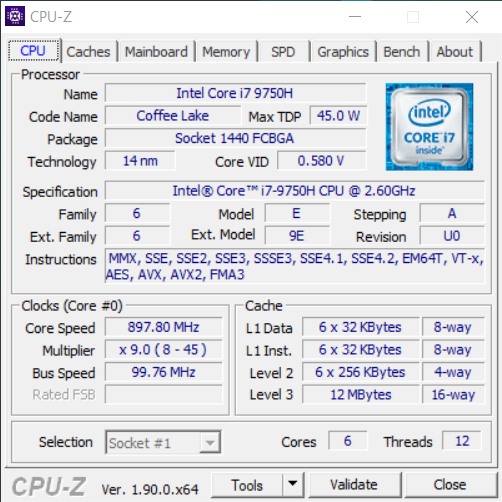
Performance - Enough for all occasions
The Core i7-9750H is an excellent choice for gaming laptops, but it is the only CPU that Acer offers with this year's Helios 300. By contrast, you can choose between the NVIDIA GeForce GTX 1660 Ti and RTX 20 GPUs. While the former is powerful enough for 1080p gaming, RTX 20 GPUs support ray tracing and DLSS.
The hardware in our review unit proved powerful enough for all tasks during our tests. We encountered no driver instability or compatibility issues either.

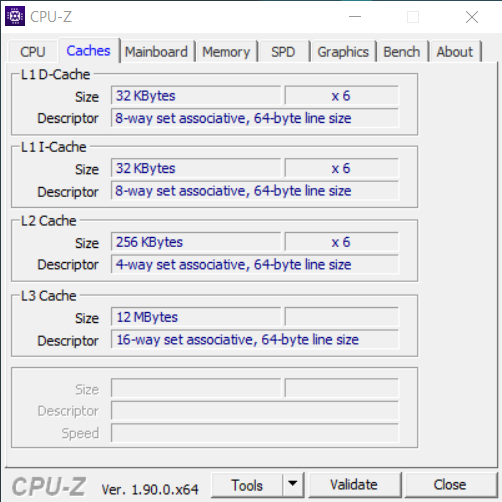
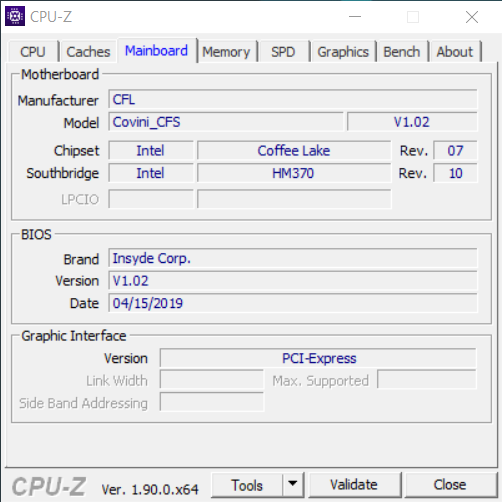
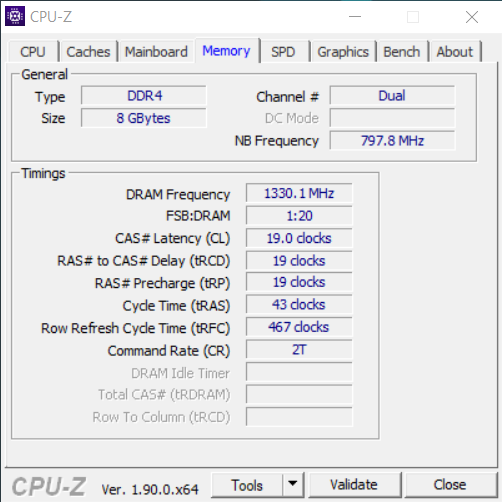
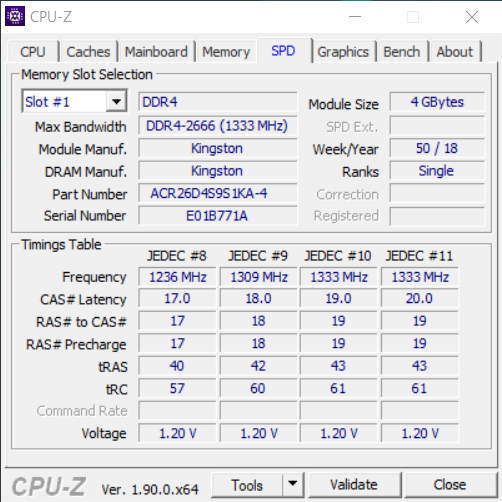
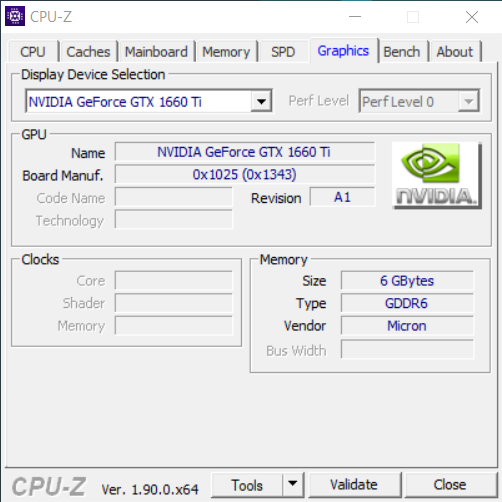
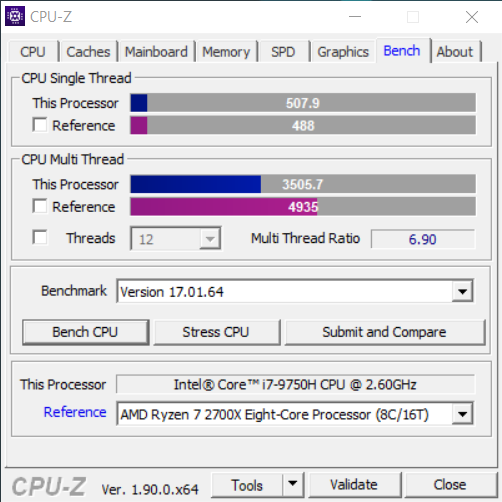
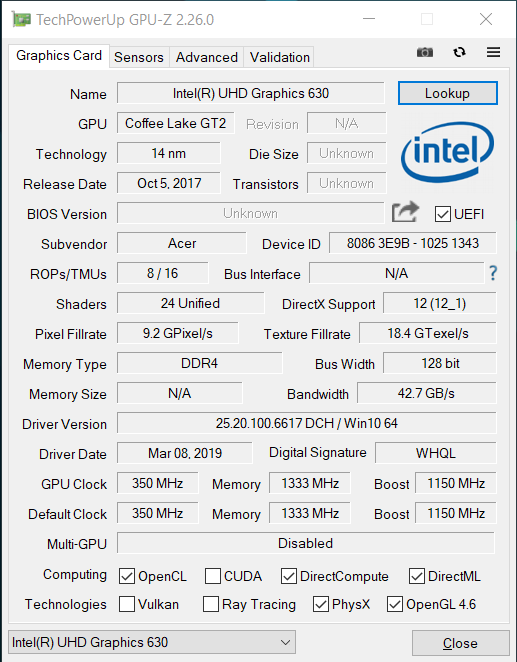
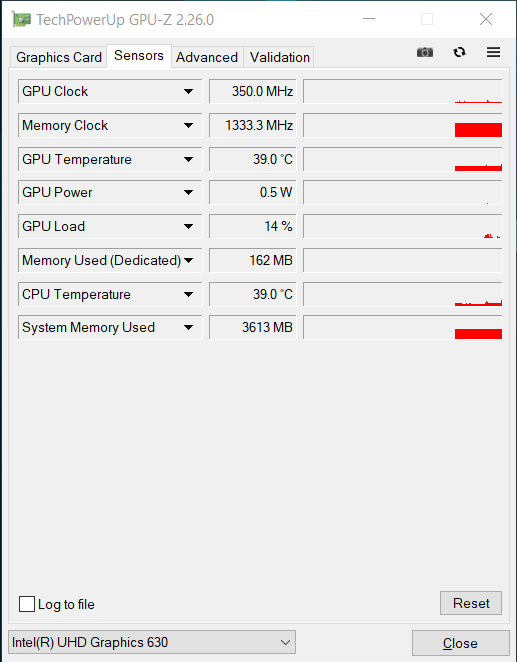
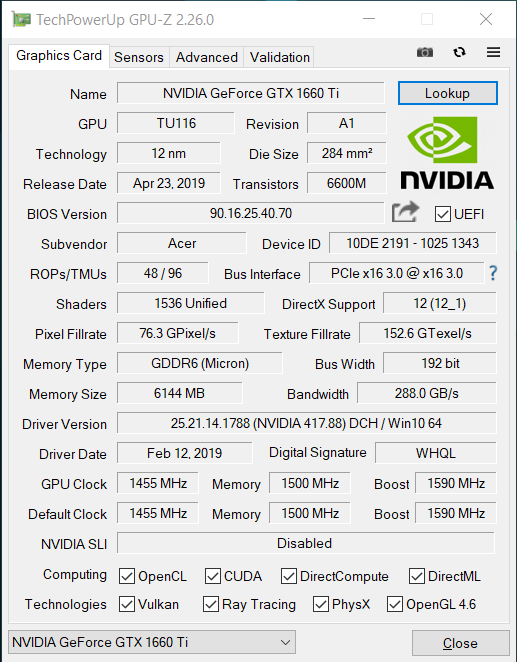
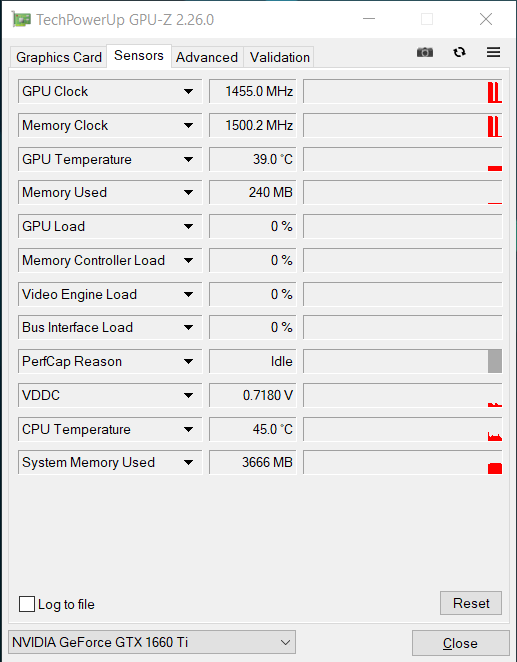
Processor
A look at the heatsink covering the Intel Core i7-9750H

The Core i7-9750H has a 2.6 GHz base clock that it can achieve across all its six cores. The Coffee Lake series chip can also Turbo Boost up to 4.5 GHz on two cores or 4 GHz on six. The length of time that the CPU can maintain its Turbo Boost for depends on the effectiveness of the cooling system with which it is paired, though.
We subjected our review unit to a looped Cinebench R15 Multi 64Bit benchmark to discover how well the system fared under sustained load. While performance dropped slightly after the first run-through, this is no worse than the behaviour of our comparison devices. The Helios 300 averaged 1,113 points during this test, which puts it in the midfield of our comparison devices. The device throttles CPU performance by around 30% when running on battery power, though.
Please see our CPU comparison page for more information about the Core i7-9750H and how it fares against other processors.



The Core i7-9750H has a 2.6 GHz base clock that it can achieve across all its six cores. The Coffee Lake series chip can also Turbo Boost up to 4.5 GHz on two cores or 4 GHz on six. The length of time that the CPU can maintain its Turbo Boost for depends on the effectiveness of the cooling system with which it is paired, though.
We subjected our review unit to a looped Cinebench R15 Multi 64Bit benchmark to discover how well the system fared under sustained load. While performance dropped slightly after the first run-through, this is no worse than the behaviour of our comparison devices. The Helios 300 averaged 1,113 points during this test, which puts it in the midfield of our comparison devices. The device throttles CPU performance by around 30% when running on battery power, though.
Please see our CPU comparison page for more information about the Core i7-9750H and how it fares against other processors.
Cinebench R15
|
||||||||||||||||||||||||||||||||||
| ||||||||||||||||||||||||||||||||||



System Performance
The Helios 300 has solid system performance too. While we also encountered no performance issues during our tests, synthetic benchmarks did not reflect our impressions. In PCMark 10, for example, the Helios 300 finished towards the bottom of the pack, and it was up to 30% behind some of our comparison devices.
PCMark 10 | PCMark 8
PCMark 10
|
|
Digital Content Creation
|
|
Lenovo Legion Y740-15ICHg
GeForce RTX 2070 Max-Q, 9750H, WDC PC SN520 SDAPMUW-128G |
8220 Points ∼100%+31%
|
Lenovo Legion Y540-15IRH-81SX00B2GE
GeForce GTX 1660 Ti (Laptop), 9750H, WDC PC SN720 SDAPNTW-512G |
7564 Points ∼92%+21%
|
Average Intel Core i7-9750H, NVIDIA GeForce GTX 1660 Ti
(Laptop)
(5898 - 7638, n=14) |
6711 Points ∼82%+7%
|
HP Gaming Pavilion 15-dk0009ng
GeForce GTX 1660 Ti Max-Q, 9750H, Samsung SSD PM981 MZVLB256HAHQ |
6502 Points ∼79%+4%
|
Average of class Gaming
(1764 - 11245, n=231) |
6450 Points ∼78%+3%
|
Acer Predator Helios 300 PH315-52-79TY
GeForce GTX 1660 Ti (Laptop), 9750H, WDC PC SN720 SDAPNTW-512G |
6335 Points ∼77%+1%
|
Dell G5 15 5590
GeForce RTX 2060 (Laptop), 8750H, KBG30ZMS128G |
6252 Points ∼76%0%
|
Productivity
|
|
HP Gaming Pavilion 15-dk0009ng
GeForce GTX 1660 Ti Max-Q, 9750H, Samsung SSD PM981 MZVLB256HAHQ |
7687 Points ∼100%+13%
|
Average Intel Core i7-9750H, NVIDIA GeForce GTX 1660 Ti
(Laptop)
(7241 - 8136, n=14) |
7531 Points ∼98%+11%
|
Lenovo Legion Y540-15IRH-81SX00B2GE
GeForce GTX 1660 Ti (Laptop), 9750H, WDC PC SN720 SDAPNTW-512G |
7430 Points ∼97%+9%
|
Lenovo Legion Y740-15ICHg
GeForce RTX 2070 Max-Q, 9750H, WDC PC SN520 SDAPMUW-128G |
7381 Points ∼96%+8%
|
Acer Predator Helios 300 PH315-52-79TY
GeForce GTX 1660 Ti (Laptop), 9750H, WDC PC SN720 SDAPNTW-512G |
|
Average of class Gaming
(4175 - 9077, n=232) |
7202 Points ∼94%+6%
|
Dell G5 15 5590
GeForce RTX 2060 (Laptop), 8750H, KBG30ZMS128G |
6808 Points ∼89%0%
|
Essentials
|
|
HP Gaming Pavilion 15-dk0009ng
GeForce GTX 1660 Ti Max-Q, 9750H, Samsung SSD PM981 MZVLB256HAHQ |
9450 Points ∼100%+1%
|
Average Intel Core i7-9750H, NVIDIA GeForce GTX 1660 Ti
(Laptop)
(8621 - 10098, n=14) |
9367 Points ∼99%0%
|
Lenovo Legion Y740-15ICHg
GeForce RTX 2070 Max-Q, 9750H, WDC PC SN520 SDAPMUW-128G |
9364 Points ∼99%0%
|
Lenovo Legion Y540-15IRH-81SX00B2GE
GeForce GTX 1660 Ti (Laptop), 9750H, WDC PC SN720 SDAPNTW-512G |
9020 Points ∼95%-4%
|
Acer Predator Helios 300 PH315-52-79TY
GeForce GTX 1660 Ti (Laptop), 9750H, WDC PC SN720 SDAPNTW-512G |
8621 Points ∼91%-8%
|
Average of class Gaming
(4892 - 11266, n=233) |
8578 Points ∼91%-8%
|
Dell G5 15 5590
GeForce RTX 2060 (Laptop), 8750H, KBG30ZMS128G |
8308 Points ∼88%-11%
|
Score
|
|
Lenovo Legion Y740-15ICHg
GeForce RTX 2070 Max-Q, 9750H, WDC PC SN520 SDAPMUW-128G |
5938 Points ∼100%+6%
|
Lenovo Legion Y540-15IRH-81SX00B2GE
GeForce GTX 1660 Ti (Laptop), 9750H, WDC PC SN720 SDAPNTW-512G |
5716 Points ∼96%+2%
|
HP Gaming Pavilion 15-dk0009ng
GeForce GTX 1660 Ti Max-Q, 9750H, Samsung SSD PM981 MZVLB256HAHQ |
5583 Points ∼94%0%
|
Average Intel Core i7-9750H, NVIDIA GeForce GTX 1660 Ti
(Laptop)
(5273 - 5829, n=14) |
5582 Points ∼94%0%
|
Acer Predator Helios 300 PH315-52-79TY
GeForce GTX 1660 Ti (Laptop), 9750H, WDC PC SN720 SDAPNTW-512G |
5279 Points ∼89%-5%
|
Average of class Gaming
(2603 - 7511, n=235) |
5264 Points ∼89%-6%
|
Dell G5 15 5590
GeForce RTX 2060 (Laptop), 8750H, KBG30ZMS128G |
5069 Points ∼85%
|
PCMark 8 Home Score
Accelerated v2
|
4688 points
|
|
PCMark 8 Creative
Score Accelerated v2
|
7682 points
|
|
PCMark 8 Work Score
Accelerated v2
|
5483 points
|
Storage Devices

A look at the 512 GB M.2 2280 SSD in our review unit
Acer has equipped our review unit with a 512 GB SSD, specifically the WDC PC SN720. The NVMe drive achieved excellent transfer speeds in AS SSD and CrystalDiskMark, blowing away all but the equally equipped Legion Y540 of our comparison devices. We particularly like that the drive offers 4K read speeds of over 40 MB/s.
The Helios 300 has two M.2 2280 slots and one 2.5-inch drive bay, which is handy. However, we would have preferred a larger drive, especially considering how much storage some games take up nowadays. You could configure or retrofit the device with a larger SSD if you plan to have several games installed simultaneously, though.
Please see our HDD/SSD comparison page for more information and benchmarks.
Acer has equipped our review unit with a 512 GB SSD, specifically the WDC PC SN720. The NVMe drive achieved excellent transfer speeds in AS SSD and CrystalDiskMark, blowing away all but the equally equipped Legion Y540 of our comparison devices. We particularly like that the drive offers 4K read speeds of over 40 MB/s.
The Helios 300 has two M.2 2280 slots and one 2.5-inch drive bay, which is handy. However, we would have preferred a larger drive, especially considering how much storage some games take up nowadays. You could configure or retrofit the device with a larger SSD if you plan to have several games installed simultaneously, though.
Please see our HDD/SSD comparison page for more information and benchmarks.
Acer Predator Helios 300 PH315-52-79TY WDC PC SN720 SDAPNTW-512G |
Acer Predator Helios 300 PH317-52-51M6
Hynix HFS128G39TND |
|
CrystalDiskMark 5.2 / 6
|
-45%
|
|
Write 4K
|
134.2
23%
|
|
Read 4K
|
37.72
-16%
|
|
Write Seq
|
389.2
-84%
|
|
Read Seq
|
1030
-36%
|
|
Write 4K Q32T1
|
238.9
-33%
|
|
Read 4K Q32T1
|
343.9
-38%
|
|
Write Seq Q32T1
|
789.1
-69%
|
|
Read Seq Q32T1
|
1501.9
-53%
|
|
Write 4K Q8T8
|
293.4
-74%
|
|
Read 4K Q8T8
|
405.8
-70%
|
|
AS SSD
|
-46%
|
|
Copy Game MB/s
|
650.44
-33%
|
|
Copy Program MB/s
|
426.02
-10%
|
|
Copy ISO MB/s
|
1061.83
-27%
|
|
Score Total
|
1065
-74%
|
|
Score Write
|
366
-80%
|
|
Score Read
|
475
-70%
|
|
Access Time Write *
|
0.037
-3%
|
|
Access Time Read *
|
0.132
-53%
|
|
4K-64 Write
|
191.35
-87%
|
|
4K-64 Read
|
302.13
-76%
|
|
4K Write
|
99.89
-3%
|
|
4K Read
|
35.42
-10%
|
|
Seq Write
|
746
-63%
|
|
Seq Read
|
1372
-52%
|
|
Total Average (Program / Settings)
|
-46% / -45%
|
Graphics Card


A look at the heatsink covering the NVIDIA GeForce GTX 1660 Ti
The graphics card is one of the most important components in a gaming laptop, and the new Helios 300 does not disappoint. Our review unit has a GeForce GTX 1660 Ti, a Turing architecture GPU that has 6 GB of VRAM. The card is powerful enough to play modern triple-A titles at 1080p, so you will need to step up to a GeForce RTX 2060 or GeForce RTX 2070 if you fancy gaming at 1440p or beyond on an external monitor.
The Helios 300 also has an Intel UHD Graphics 630 onboard courtesy of its Core i7-9750H processor. This integrated GPU takes over from the GeForce GTX 1660 Ti during undemanding tasks, allowing the Helios 300 to consume less power and achieve better battery life.
Please see our GPU comparison page for more information about the GeForce GTX 1660 Ti and how it compares against other graphics cards.
3DMark 11 | 3DMark
Gaming Performance
The Helios 300 performed well in all our gaming tests, although it cannot get quite as much performance from its GPU as the equally equipped HP Gaming Pavilion 15 can. The difference only equates to a few frames per second, though. Only our GeForce RTX 2060 and GeForce RTX 2070-powered comparison devices perform noticeably better than our review unit does.
Our review unit breezed through longer gaming sessions too. We verified this by letting The Witcher 3 run for an hour on the ultra preset at 1080p, during which the device achieved between 47 and 58 FPS. Hence, you should encounter no throttling when gaming for prolonged periods.
Emissions - Quiet, slightly too warm and underwhelming speakers
Fan Noise
Pretty much all gaming laptops have loud fans, and the new Helios 300 is
no different. The two fans in our review unit reach a maximum of 31 dB(A) at idle but peak at 46.9 dB(A) under sustained load. You can typically expect fan noise to reach 41.5 dB(A) when gaming, though.
Noise Level
Idle
31 / 31 / 31 dB(A)
Load
41.5 / 46.9 dB(A)
30 dB
silent
40 dB(A)
audible
50 dB(A)
loud
min:![]() , med:
, med: ![]() , max:
, max: ![]() Audix TM1, Arta (15 cm distance) environment noise: 30.2 dB(A)
Audix TM1, Arta (15 cm distance) environment noise: 30.2 dB(A)
Temperature

The graphics card is one of the most important components in a gaming laptop, and the new Helios 300 does not disappoint. Our review unit has a GeForce GTX 1660 Ti, a Turing architecture GPU that has 6 GB of VRAM. The card is powerful enough to play modern triple-A titles at 1080p, so you will need to step up to a GeForce RTX 2060 or GeForce RTX 2070 if you fancy gaming at 1440p or beyond on an external monitor.
The Helios 300 also has an Intel UHD Graphics 630 onboard courtesy of its Core i7-9750H processor. This integrated GPU takes over from the GeForce GTX 1660 Ti during undemanding tasks, allowing the Helios 300 to consume less power and achieve better battery life.
Please see our GPU comparison page for more information about the GeForce GTX 1660 Ti and how it compares against other graphics cards.
3DMark 11 | 3DMark
%
|
|
Acer Predator Helios 300 PH315-52-79TY
NVIDIA GeForce GTX 1660 Ti (Laptop), Intel Core i7-9750H |
19435 Points ∼89%+41%
|
HP Gaming Pavilion 15-dk0009ng
NVIDIA GeForce GTX 1660 Ti Max-Q, Intel Core i7-9750H |
17264 Points ∼79%+25%
|
Average of class Gaming
(513 - 50983, n=641) |
13786 Points ∼63%0%
|
Acer Predator Helios 300 PH317-52-51M6
NVIDIA GeForce GTX 1050 Ti (Laptop), Intel Core i5-8300H |
9147 Points ∼42%-34%
|
3DMark 11 Performance
|
16344 points
|
|
3DMark Ice Storm Standard Score
|
106089 points
|
|
3DMark Cloud Gate Standard Score
|
35033 points
|
|
3DMark Fire Strike Score
|
12903 points
|
|
3DMark Fire Strike Extreme Score
|
6532 points
|
|
3DMark Time Spy Score
|
5615 points
|
Gaming Performance
The Helios 300 performed well in all our gaming tests, although it cannot get quite as much performance from its GPU as the equally equipped HP Gaming Pavilion 15 can. The difference only equates to a few frames per second, though. Only our GeForce RTX 2060 and GeForce RTX 2070-powered comparison devices perform noticeably better than our review unit does.
Our review unit breezed through longer gaming sessions too. We verified this by letting The Witcher 3 run for an hour on the ultra preset at 1080p, during which the device achieved between 47 and 58 FPS. Hence, you should encounter no throttling when gaming for prolonged periods.
Emissions - Quiet, slightly too warm and underwhelming speakers
Fan Noise
Pretty much all gaming laptops have loud fans, and the new Helios 300 is
no different. The two fans in our review unit reach a maximum of 31 dB(A) at idle but peak at 46.9 dB(A) under sustained load. You can typically expect fan noise to reach 41.5 dB(A) when gaming, though.
Noise Level
Idle
31 / 31 / 31 dB(A)
Load
41.5 / 46.9 dB(A)
30 dB
silent
40 dB(A)
audible
50 dB(A)
loud
min:
Acer Predator Helios 300 PH315-52-79TY
GeForce GTX 1660 Ti (Laptop), 9750H, WDC PC SN720 SDAPNTW-512G |
30.2
|
-1%
|
Noise
|
31
|
29
4%
|
off
/ environment *
|
31
|
29
6%
|
Idle
Minimum *
|
31
|
31
-0%
|
Idle
Average *
|
41.5
|
33
-6%
|
Idle
Maximum *
|
46.7
|
45
-8%
|
Load
Average *
|
46.9
|
45
4%
|
Witcher
3 ultra *
|
||
Load
Maximum *
|
Temperature

3DMark 11 results after running our stress test
While the Helios 300 stays cool to the touch when idling, most areas get hot under sustained load. Even though the palm rest averages around 30 °C when gaming, the 52 °C hotspot that we measured during our stress tests means that the Helios 3 runs much hotter than our comparison devices.
Please keep in mind that it is possible to reduce surface and internal temperatures by manually setting the fans to run at 100% constantly. Doing so reduced peak surface temperatures to just 46 °C, although you must endure the fans at their noisiest.
We also subjected our review unit to FurMark and Prime95 stress tests, during which CPU core temperatures reached 93 °C. The Helios 300 thermal throttled at this point, but we did not encounter this when we just ran Prime95.
The effects of our FurMark and Prime95 stress test did not last long, though. As the 3DMark 11 screenshot to the right demonstrates, the Helios 300 performed just as well as it did when we ran benchmarks from a cold start.
(-) The average temperature for the upper side under maximal load is 40.6 °C / 105 F, compared to the average of 33.2 °C / 92 F for the devices in the class Gaming.
(-) The maximum temperature on the upper side is 52 °C / 126 F, compared to the average of 39.6 °C / 103 F, ranging from 21.6 to 68.8 °C for the class Gaming.
(-) The bottom heats up to a maximum of 46.3 °C / 115 F, compared to the average of 42.3 °C / 108 F
(+) In idle usage, the average temperature for the upper side is 24.1 °C / 75 F, compared to the device average of 33.2 °C / 92 F.
(±) Playing The Witcher 3, the average temperature for the upper side is 38 °C / 100 F, compared to the device average of 33.2 °C / 92 F.
(+) The palmrests and touchpad are reaching skin temperature as a maximum (33 °C / 91.4 F) and are therefore not hot.
(-) The average temperature of the palmrest area of similar devices was 28.8 °C / 83.8 F (-4.2 °C / -7.6 F).
Speakers
Acer equips the Helios 300 with stereo speakers, although the absence of a subwoofer restricts our enjoyment somewhat. The speakers in our review unit are disappointingly quiet and struggle to reproduce any bass tones, although they have no problems with high and mid frequencies. The speakers fire downwards too, so audio will sound muffled if you place the Helios 300 on a soft surface, for example. There are a few predefined sound profiles in Predator Sense should you wish to tune how the speakers sound. While there is an audible difference between each profile, none can mitigate against the poor placement and underwhelming drivers that Acer has included in our review unit.
In short, we would recommend using external speakers or headphones when listening to music or gaming. These can be connected via the 3.5 mm jack, Bluetooth, or USB.
Frequency diagram (checkboxes can be checked and unchecked to compare devices)
Acer Predator Helios 300 PH315-52-79TY audio analysis
(-) | not very loud speakers (69.19 dB)
Bass 100 - 315 Hz
(-) | nearly no bass - on average 22.4% lower than median
(±) | linearity of bass is average (12.4% delta to prev. frequency)
Mids 400 - 2000 Hz
(+) | balanced mids - only 3.8% away from median
(±) | linearity of mids is average (9.8% delta to prev. frequency)
Highs 2 - 16 kHz
(+) | balanced highs - only 2% away from median
(+) | highs are linear (6.9% delta to prev. frequency)
Overall 100 - 16.000 Hz
(±) | linearity of overall sound is average (19.1% difference to median)
Compared to same class
» 64% of all tested devices in this class were better, 5% similar, 31% worse
» The best had a delta of 6%, average was 17%, worst was 37%
Compared to all devices tested
» 37% of all tested devices were better, 7% similar, 56% worse
» The best had a delta of 3%, average was 21%, worst was 53%
Lenovo Legion Y540-15IRH-81SX00B2GE audio analysis
(±) | speaker loudness is average but good (77.4 dB)
Bass 100 - 315 Hz
(-) | nearly no bass - on average 17.7% lower than median
(±) | linearity of bass is average (11.6% delta to prev. frequency)
Mids 400 - 2000 Hz
(+) | balanced mids - only 3.7% away from median
(+) | mids are linear (4.5% delta to prev. frequency)
Highs 2 - 16 kHz
(+) | balanced highs - only 3.3% away from median
(+) | highs are linear (5.9% delta to prev. frequency)
Overall 100 - 16.000 Hz
(±) | linearity of overall sound is average (16% difference to median)
Compared to same class
» 41% of all tested devices in this class were better, 7% similar, 52% worse
» The best had a delta of 6%, average was 17%, worst was 37%
Compared to all devices tested
» 19% of all tested devices were better, 4% similar, 77% worse
» The best had a delta of 3%, average was 21%, worst was 53%
Power Management - High power consumption and a 58 Wh battery equals short battery life
Power Consumption


While the Helios 300 stays cool to the touch when idling, most areas get hot under sustained load. Even though the palm rest averages around 30 °C when gaming, the 52 °C hotspot that we measured during our stress tests means that the Helios 3 runs much hotter than our comparison devices.
Please keep in mind that it is possible to reduce surface and internal temperatures by manually setting the fans to run at 100% constantly. Doing so reduced peak surface temperatures to just 46 °C, although you must endure the fans at their noisiest.
We also subjected our review unit to FurMark and Prime95 stress tests, during which CPU core temperatures reached 93 °C. The Helios 300 thermal throttled at this point, but we did not encounter this when we just ran Prime95.
The effects of our FurMark and Prime95 stress test did not last long, though. As the 3DMark 11 screenshot to the right demonstrates, the Helios 300 performed just as well as it did when we ran benchmarks from a cold start.
Max. Load
Idle
Witcher 3
| |||||||||||||||||||||||||
| Maximum: 52 °C = 126 F Average: 40.6 °C = 105 F | |||||||||||||||||||||||||
| |||||||||||||||||||||||||
| Maximum: 46.3 °C = 115 F Average: 37.1 °C = 99 F | |||||||||||||||||||||||||
Power Supply (max.) 54.4 °C = 130 F | Room Temperature 22.4 °C = 72 F | FIRT 550-Pocket
(-) The average temperature for the upper side under maximal load is 40.6 °C / 105 F, compared to the average of 33.2 °C / 92 F for the devices in the class Gaming.
(-) The maximum temperature on the upper side is 52 °C / 126 F, compared to the average of 39.6 °C / 103 F, ranging from 21.6 to 68.8 °C for the class Gaming.
(-) The bottom heats up to a maximum of 46.3 °C / 115 F, compared to the average of 42.3 °C / 108 F
(+) In idle usage, the average temperature for the upper side is 24.1 °C / 75 F, compared to the device average of 33.2 °C / 92 F.
(±) Playing The Witcher 3, the average temperature for the upper side is 38 °C / 100 F, compared to the device average of 33.2 °C / 92 F.
(+) The palmrests and touchpad are reaching skin temperature as a maximum (33 °C / 91.4 F) and are therefore not hot.
(-) The average temperature of the palmrest area of similar devices was 28.8 °C / 83.8 F (-4.2 °C / -7.6 F).
Acer Predator Helios 300 PH315-52-79TY
GeForce GTX 1660 Ti (Laptop), 9750H, WDC PC SN720 SDAPNTW-512G |
||
Heat
|
||
Maximum Upper Side *
|
46.3
|
-15%
|
Maximum Bottom *
|
24.8
|
50
4%
|
Idle Upper Side *
|
25.4
|
52
-12%
|
Idle Bottom *
|
33
-33%
|
|
30
-18%
|
Speakers
Acer equips the Helios 300 with stereo speakers, although the absence of a subwoofer restricts our enjoyment somewhat. The speakers in our review unit are disappointingly quiet and struggle to reproduce any bass tones, although they have no problems with high and mid frequencies. The speakers fire downwards too, so audio will sound muffled if you place the Helios 300 on a soft surface, for example. There are a few predefined sound profiles in Predator Sense should you wish to tune how the speakers sound. While there is an audible difference between each profile, none can mitigate against the poor placement and underwhelming drivers that Acer has included in our review unit.
In short, we would recommend using external speakers or headphones when listening to music or gaming. These can be connected via the 3.5 mm jack, Bluetooth, or USB.
Acer Predator Helios 300 PH315-52-79TY audio analysis
(-) | not very loud speakers (69.19 dB)
Bass 100 - 315 Hz
(-) | nearly no bass - on average 22.4% lower than median
(±) | linearity of bass is average (12.4% delta to prev. frequency)
Mids 400 - 2000 Hz
(+) | balanced mids - only 3.8% away from median
(±) | linearity of mids is average (9.8% delta to prev. frequency)
Highs 2 - 16 kHz
(+) | balanced highs - only 2% away from median
(+) | highs are linear (6.9% delta to prev. frequency)
Overall 100 - 16.000 Hz
(±) | linearity of overall sound is average (19.1% difference to median)
Compared to same class
» 64% of all tested devices in this class were better, 5% similar, 31% worse
» The best had a delta of 6%, average was 17%, worst was 37%
Compared to all devices tested
» 37% of all tested devices were better, 7% similar, 56% worse
» The best had a delta of 3%, average was 21%, worst was 53%
Lenovo Legion Y540-15IRH-81SX00B2GE audio analysis
(±) | speaker loudness is average but good (77.4 dB)
Bass 100 - 315 Hz
(-) | nearly no bass - on average 17.7% lower than median
(±) | linearity of bass is average (11.6% delta to prev. frequency)
Mids 400 - 2000 Hz
(+) | balanced mids - only 3.7% away from median
(+) | mids are linear (4.5% delta to prev. frequency)
Highs 2 - 16 kHz
(+) | balanced highs - only 3.3% away from median
(+) | highs are linear (5.9% delta to prev. frequency)
Overall 100 - 16.000 Hz
(±) | linearity of overall sound is average (16% difference to median)
Compared to same class
» 41% of all tested devices in this class were better, 7% similar, 52% worse
» The best had a delta of 6%, average was 17%, worst was 37%
Compared to all devices tested
» 19% of all tested devices were better, 4% similar, 77% worse
» The best had a delta of 3%, average was 21%, worst was 53%
Power Management - High power consumption and a 58 Wh battery equals short battery life
Power Consumption


Acer includes a 180 W power supply in the box.
The Helios 300 falls short of our expectations here. Simply, our review unit consistently consumes more power than it should, especially when idling or under medium load. Its peak draw of 177 W makes it more economical than the competition in at least one aspect, though.
Acer pairs the Helios 300 with a 180 W power supply. While our review unit never exceeded this wattage during our tests, we noticed that the power supply could not always keep the device at 100% charge.
Battery Life

The Helios 300 falls short of our expectations here. Simply, our review unit consistently consumes more power than it should, especially when idling or under medium load. Its peak draw of 177 W makes it more economical than the competition in at least one aspect, though.
Acer pairs the Helios 300 with a 180 W power supply. While our review unit never exceeded this wattage during our tests, we noticed that the power supply could not always keep the device at 100% charge.
Power Consumption
| Off / Standby | |
| Idle | |
| Load | |
| Key: min: | |
Battery Life

CB R15 Multi 64Bit scores on battery
Acer equips the Helios 300 with a 58 Wh battery, which achieved comparatively poor runtimes during our tests. Our review unit drains its battery in under five hours when idling, while it needed recharging after only 3.5 hours on Wi-Fi. We ran the latter test with the display set to around 150 cd/m² too, which is a level that should represent general conditions in our opinion.
Worse still, the Helios 300 throttles its CPU and GPU performance when running on battery power. Benchmark results to the right demonstrate how drastically our review unit restricts performance on battery, which is doubly disappointing considering how poor its battery life is. Incidentally, the Helios 300 takes just over 90 minutes to recharge fully with the included power supply.

Battery life at idle

Battery life under sustained load

Battery life on Wi-Fi

Battery life on Wi-Fi at maximum brightness

Battery life while looping an H.264 video

Charging time
Pros+modern design
+stable chassis
+three drive bays
+powerful enough for 1080p triple-A gaming
+IPS display
+144 Hz refresh rate
+no PWM
+good Wi-Fi performance
+Predator Sense with useful features
+fast NVMe SSD
Cons-unacceptably high power consumption when idling and under medium load
-short battery life
-no SD card reader
-only 512 GB of storage
-noticeable backlight bleeding
Verdict - A powerful 1080p gaming laptop with flaws

Acer equips the Helios 300 with a 58 Wh battery, which achieved comparatively poor runtimes during our tests. Our review unit drains its battery in under five hours when idling, while it needed recharging after only 3.5 hours on Wi-Fi. We ran the latter test with the display set to around 150 cd/m² too, which is a level that should represent general conditions in our opinion.
Worse still, the Helios 300 throttles its CPU and GPU performance when running on battery power. Benchmark results to the right demonstrate how drastically our review unit restricts performance on battery, which is doubly disappointing considering how poor its battery life is. Incidentally, the Helios 300 takes just over 90 minutes to recharge fully with the included power supply.

Battery life at idle

Battery life under sustained load

Battery life on Wi-Fi

Battery life on Wi-Fi at maximum brightness

Battery life while looping an H.264 video

Charging time
Battery Runtime
Idle (without WLAN,
min brightness)
|
4h 58min
|
|
NBC WiFi Websurfing
Battery Test 1.3 (Edge: 44.18362.387.0)
|
3h 30min
|
|
NBC WiFi Websurfing
Battery Test 1.3 max Brightness (Edge: 44.18362.387.0)
|
2h 56min
|
|
Big Buck Bunny H.264
1080p
|
3h 22min
|
|
Load (maximum
brightness)
|
1h 13min
|
Pros+modern design
+stable chassis
+three drive bays
+powerful enough for 1080p triple-A gaming
+IPS display
+144 Hz refresh rate
+no PWM
+good Wi-Fi performance
+Predator Sense with useful features
+fast NVMe SSD
Cons-unacceptably high power consumption when idling and under medium load
-short battery life
-no SD card reader
-only 512 GB of storage
-noticeable backlight bleeding
Verdict - A powerful 1080p gaming laptop with flaws

The Acer Predator Helios 300 PH315 laptop review. Test device courtesy of notebooksbilliger.de.
The Acer Predator Helios 300 PH315 is a modern gaming laptop with acceptable gaming performance. The entry-level model is not competitively priced at around 1,400 Euros (~$1,550), though. Nevertheless, the overhauled 15-inch laptop is well designed and features hardware that can handle all current triple-A games natively at 1080p.
While we always like seeing OEMs include 144 Hz panels on their gaming laptops, high refresh-rate displays have now become the norm. However, the one in our review unit left us with a bit of a sour aftertaste. On the one hand, it is bright and colour accurate, both laudable qualities. On the other, it suffers from obnoxious backlight bleeding, something that we would not have expected on such an expensive laptop. Separately, including 512 GB of storage on a gaming laptop feels rather stingy, so we would recommend choosing the 1 TB option if possible. Otherwise, you may find yourself quickly needing to add a second drive, especially with some games now requiring over 100 GB of space.
The Acer Predator Helios 300 PH315 is a solid entry-level gaming laptop in a new guise. Some shortcomings remain, though.
Retrofitting additional drives is relatively simple to do, with the drive bays hiding behind a bottom plate that is easy to remove. While we have hardly any criticisms about build quality, the Helios 300 PH315 consumes more power than it should in our opinion. Overall, while the device has some downsides, like short battery life and sub-par speakers, it is ultimately a decent gaming laptop.
Acer Predator Helios 300 PH315-52-79TY - 11/01/2019 v7
Sebastian Bade
Chassis
80 / 98 → 82%
Keyboard
83%
Pointing Device
92%
Connectivity
56 / 80 → 70%
Weight
61 / 10-66 → 91%
Battery
53 / 95 → 56%
Display
84%
Games Performance
89%
Application Performance
90%
Temperature
87 / 95 → 92%
Noise
82 / 90 → 91%
Audio
57%
Average
76%
83%
Gaming - Weighted Average
The Acer Predator Helios 300 PH315 is a modern gaming laptop with acceptable gaming performance. The entry-level model is not competitively priced at around 1,400 Euros (~$1,550), though. Nevertheless, the overhauled 15-inch laptop is well designed and features hardware that can handle all current triple-A games natively at 1080p.
While we always like seeing OEMs include 144 Hz panels on their gaming laptops, high refresh-rate displays have now become the norm. However, the one in our review unit left us with a bit of a sour aftertaste. On the one hand, it is bright and colour accurate, both laudable qualities. On the other, it suffers from obnoxious backlight bleeding, something that we would not have expected on such an expensive laptop. Separately, including 512 GB of storage on a gaming laptop feels rather stingy, so we would recommend choosing the 1 TB option if possible. Otherwise, you may find yourself quickly needing to add a second drive, especially with some games now requiring over 100 GB of space.
The Acer Predator Helios 300 PH315 is a solid entry-level gaming laptop in a new guise. Some shortcomings remain, though.
Retrofitting additional drives is relatively simple to do, with the drive bays hiding behind a bottom plate that is easy to remove. While we have hardly any criticisms about build quality, the Helios 300 PH315 consumes more power than it should in our opinion. Overall, while the device has some downsides, like short battery life and sub-par speakers, it is ultimately a decent gaming laptop.
Acer Predator Helios 300 PH315-52-79TY - 11/01/2019 v7
Sebastian Bade
Chassis
80 / 98 → 82%
Keyboard
83%
Pointing Device
92%
Connectivity
56 / 80 → 70%
Weight
61 / 10-66 → 91%
Battery
53 / 95 → 56%
Display
84%
Games Performance
89%
Application Performance
90%
Temperature
87 / 95 → 92%
Noise
82 / 90 → 91%
Audio
57%
Average
76%
83%
Gaming - Weighted Average








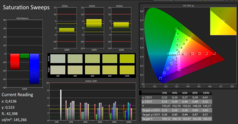






























Acer Predator Helios 300 Gaming Laptop Pc
ReplyDelete-
Gaming Pc Ex Cool >>>>> Download Now
>>>>> Download Full
Acer Predator Helios 300 Gaming Laptop Pc
-
Gaming Pc Ex Cool >>>>> Download LINK
>>>>> Download Now
Acer Predator Helios 300 Gaming Laptop Pc
-
Gaming Pc Ex Cool >>>>> Download Full
>>>>> Download LINK ld